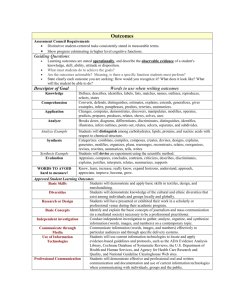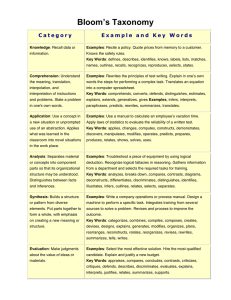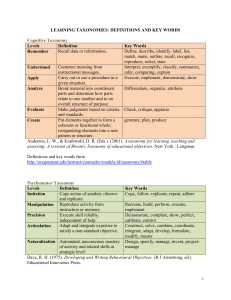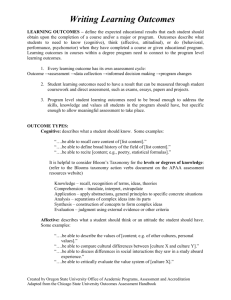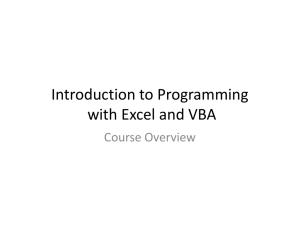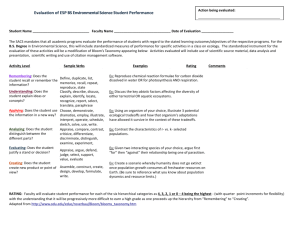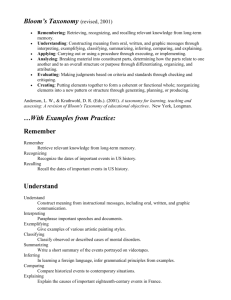Bloom`s Taxonomy Verb Chart
advertisement
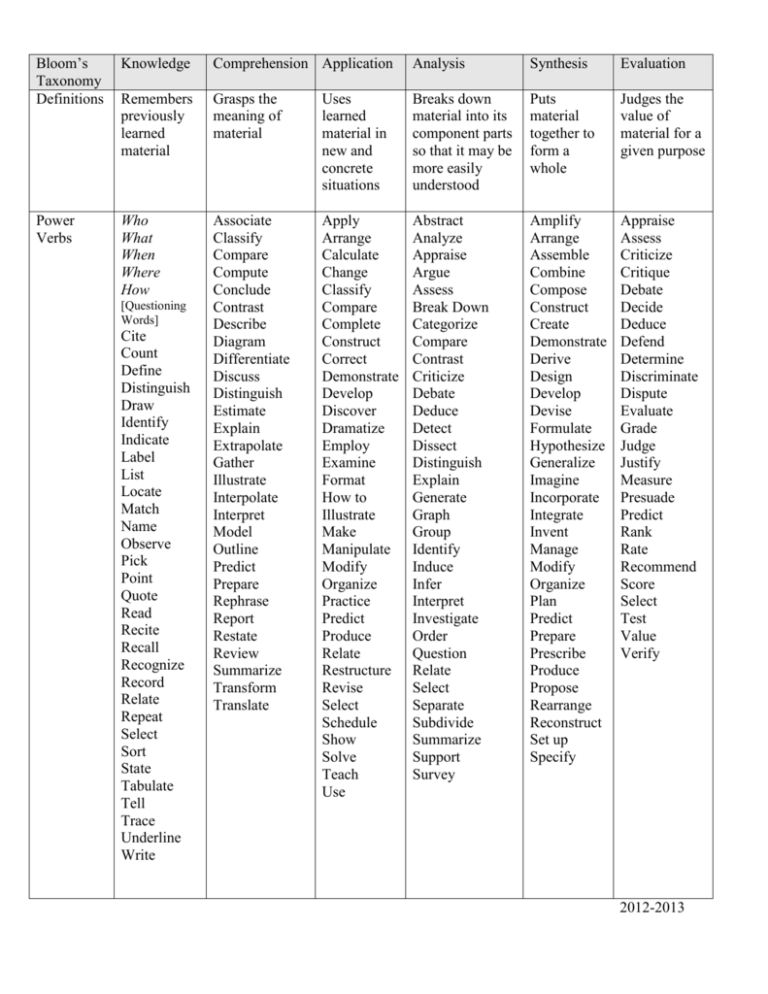
Bloom’s Taxonomy Definitions Knowledge Comprehension Application Analysis Synthesis Evaluation Remembers previously learned material Grasps the meaning of material Uses learned material in new and concrete situations Breaks down material into its component parts so that it may be more easily understood Puts material together to form a whole Judges the value of material for a given purpose Power Verbs Who What When Where How Associate Classify Compare Compute Conclude Contrast Describe Diagram Differentiate Discuss Distinguish Estimate Explain Extrapolate Gather Illustrate Interpolate Interpret Model Outline Predict Prepare Rephrase Report Restate Review Summarize Transform Translate Apply Arrange Calculate Change Classify Compare Complete Construct Correct Demonstrate Develop Discover Dramatize Employ Examine Format How to Illustrate Make Manipulate Modify Organize Practice Predict Produce Relate Restructure Revise Select Schedule Show Solve Teach Use Abstract Analyze Appraise Argue Assess Break Down Categorize Compare Contrast Criticize Debate Deduce Detect Dissect Distinguish Explain Generate Graph Group Identify Induce Infer Interpret Investigate Order Question Relate Select Separate Subdivide Summarize Support Survey Amplify Arrange Assemble Combine Compose Construct Create Demonstrate Derive Design Develop Devise Formulate Hypothesize Generalize Imagine Incorporate Integrate Invent Manage Modify Organize Plan Predict Prepare Prescribe Produce Propose Rearrange Reconstruct Set up Specify Appraise Assess Criticize Critique Debate Decide Deduce Defend Determine Discriminate Dispute Evaluate Grade Judge Justify Measure Presuade Predict Rank Rate Recommend Score Select Test Value Verify [Questioning Words] Cite Count Define Distinguish Draw Identify Indicate Label List Locate Match Name Observe Pick Point Quote Read Recite Recall Recognize Record Relate Repeat Select Sort State Tabulate Tell Trace Underline Write 2012-2013 Page 2 Bloom’s Taxonomy Concepts Knowledge Comprehension Application Analysis Synthesis Evaluation Knows: Common Terms Specific Facts Methods and Procedures Basic Concepts Understands: Facts/principles Interprets: Verbal material Interprets: Charts and Graphs Translate: Verbal material into math formulas Estimate: Future consequences implied in data Justifies: Methods and procedures Solves: math problems Constructs charts and graphs Demonstrates: Correct usage of methods/ procedures Applies: Concepts/ principles in new situations Applies: Theories to practical situations Recognizes: Unseated assumptions Recognizes: Logical fallacies in reasoning Distinguishes: Between facts and inferences Evaluates: Relevancy of data Assesses: Organizational structure of work (art, music, writing) Produces: Well organized theme, speech Composes: Creative story, poem, music Proposes: Plan for Experiment Integrates: Learning from different areas into a plan for problem solving Judges: Logical Consistency: Of written material Judges: Adequacy with which conclusions are supported by data Judges: Value of art, music, Literature using external standards Essay Research Reenactment Chart/log Report Standardized Projects Produces Creates Performs Writes Operates Integrated Report Aesthetic Assessment Compare/ Contrast Open Response Portfolio Performance Event Open Response Portfolio Performance Event Interdisciplinary Reflection Instruction Open Response Portfolio Performance Event Reflection Revision Assessment True/False Multiple Choice Short Answer Completion Matching Standardized Bloom's Taxonomy is a classification of learning objectives within education. It refers to a classification of the different objectives that educators set for students (learning objectives). The taxonomy was first presented in 1956 through the publication The Taxonomy of Educational Objectives, The Classification of Educational Goals, Handbook I: Cognitive Domain, byBenjamin Bloom (editor), M. D. Englehart, E. J. Furst, W. H. Hill, and David Krathwohl. It is considered to be a foundational and essential element within the education community as evidenced in the 1981 survey Significant writings that have influenced the curriculum: 1906-1981, by H. G. Shane and the 1994 yearbook of the National Society for the Study of Education. Domain The cognitive domain (Bloom, 1956) involves knowledge and the development of intellectual skills. This includes the recall or recognition of specific facts, procedural patterns, and concepts that serve in the development of intellectual abilities and skills. There are six major categories, which are listed in order below, starting from the simplest behavior to the most complex. The categories can be thought of as degrees of difficulties. That is, the first one must be mastered before the next one can take place. Category Example and Key Words Examples: Recite a policy. Quote prices from memory to a customer. Knows the safety rules. Knowledge: Recall data or information. Comprehension: Understand the meaning, translation, interpolation, and interpretation of instructions and problems. State a problem in one's own words. Application: Use a concept in a new situation or unprompted use of an abstraction. Applies what was learned in the classroom into novel situations in the work place. Key Words: defines, describes, identifies, knows, labels, lists, matches, names, outlines, recalls, recognizes, reproduces, selects, states. Examples: Rewrite the principles of test writing. Explain in one's own words the steps for performing a complex task. Translate an equation into a computer spreadsheet. Key Words: comprehends, converts, defends, distinguishes, estimates, explains, extends, generalizes, gives Examples, infers, interprets, paraphrases, predicts, rewrites, summarizes, translates. Examples: Use a manual to calculate an employee's vacation time. Apply laws of statistics to evaluate the reliability of a written test. Key Words: applies, changes, computes, constructs, demonstrates, discovers, manipulates, modifies, operates, predicts, Cognitive prepares, produces, relates, shows, solves, uses. Analysis: Separates material or concepts into component parts so that its organizational structure may be understood. Distinguishes between facts and inferences. Synthesis: Builds a structure or pattern from diverse elements. Put parts together to form a whole, with emphasis on creating a new meaning or structure. Examples: Troubleshoot a piece of equipment by using logical deduction. Recognize logical fallacies in reasoning. Gather information from a department and select the required tasks for training. Key Words: analyzes, breaks down, compares, contrasts, diagrams, deconstructs, differentiates, discriminates, distinguishes, identifies, illustrates, infers, outlines, relates, selects, separates. Examples: Write a company operations or process manual. Design a machine to perform a specific task. Integrate training from several sources to solve a problem. Revise and process to improve the outcome. Key Words: categorizes, combines, compiles, composes, creates, devises, designs, explains, generates, modifies, organizes, plans, rearranges, reconstructs, relates, reorganizes, revises, rewrites, summarizes, tells, writes. Examples: Select the most effective solution. Hire the most qualified candidate. Explain and justify a new budget. Evaluation: Make judgments about the value of ideas or materials. Key Words: appraises, compares, concludes, contrasts, criticizes, critiques, defends, describes, discriminates, evaluates, explains, interprets, justifies, relates, summarizes, supports.
